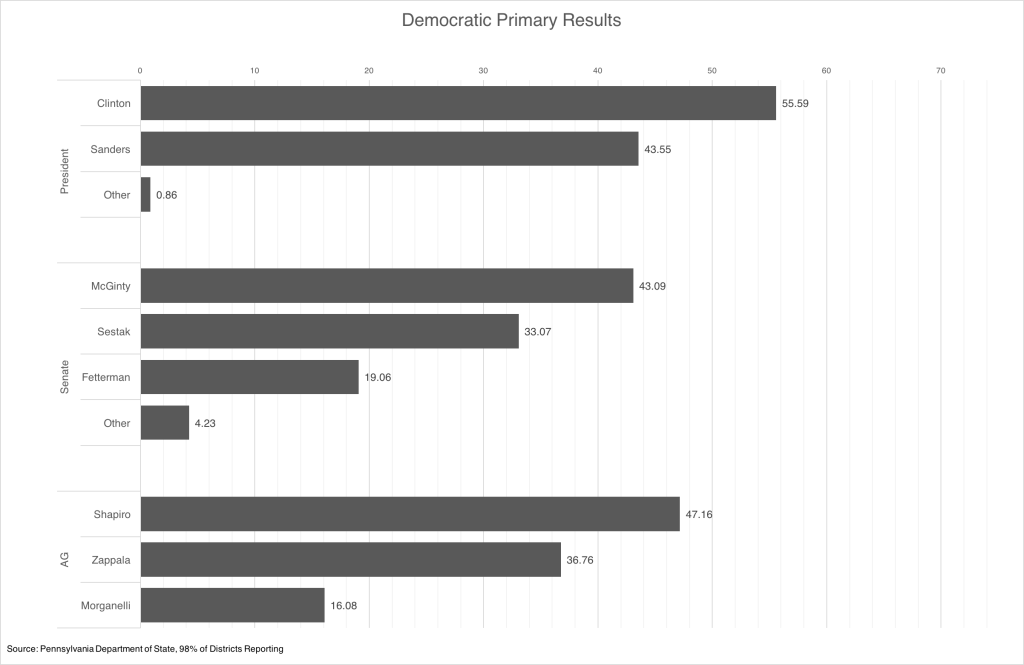Michael Berkman | Director of Center for American Political Responsiveness
Zachary Baumann | Lecturer, Department of Political Science
In an election year notable for the success of “outsider candidates,” Pennsylvania confirmed that the party establishment has a much stronger hold on the Democratic party than it does on the Republican.
Pennsylvania Democrats participated in three notable statewide races: for president, for senator and to replace Kathleen Kane as attorney general. As we can see, in all three cases, the establishment candidate won by a significant margin.
The Presidential race
Sanders has surprised many with his dramatic rise from a largely unknown Independent senator from Vermont to raising a record amount of money from a record number of contributors and beating Hillary Clinton in many states. Yet Sanders has never been the favorite of Democratic party elites — indeed, prior to this campaign, he did not even identify himself as a Democrat.
As we see below he lags far behind Hillary Clinton in endorsements from other elected Democrats, a widely used measure of establishment support. In the end, and as has largely been the case since the party democraticized its nomination process through primaries and open caucuses, the establishment won.
The pattern for the Republicans, of course, is quite different. Trump is the ultimate party outsider. Although he has been identified with the Republican party at least since he took on the role of Birther in Chief early in President Barack Obama’s first term, he has never held elective office, holds heterodox views from the dominant conservative wing of the party, and has spurred a vigorous if so far unsuccessful Stop Trump movement.
Even the endorsements he now has are fairly recent as the party has come to accept that he will be the likely nominee; earlier in the race, he had very little support from other Republican elected officials. While John Kasich held endorsements from former governors Tom Ridge and Dick Thornburg, current House member Charlie Dent and others, Trump won a majority of votes in every county across the state.
Down ballot races
The success of the Democratic establishment can be seen in some down ballot races as well. Joe Sestak — widely recognized as a successful congressman and who came within two percentage points of beating Pat Toomey in a 2010 election that was, in general, a debacle for Democrats — lost to Katie McGinty by ten percentage points.
Sestak, who has been campaigning almost continuously since his 2010 defeat, was leading in earlier polls but saw his lead slide as McGinty racked up endorsements from state and national elected officials along with substantial campaign contributions from the national Democratic party.
There are not wide ideological differences between the two — the gap is much larger with John Fetterman who did better than expected by winning nearly 20 percent of the vote — but Sestak had gone against the party’s preference that Arlen Specter not be challenged in a primary when he switched parties for the 2010 election. Sestak beat Specter but lost the party, and the establishment helped McGinty win her first statewide election.
Two other races show the same pattern: establishment success for the Democrats, but a much weaker establishment for the Republicans.
Josh Shapiro, endorsed by nearly two-thirds of Pennsylvania elected officials identified by the website Billypenn.com, won easily over Stephen Zappala.(Republican John Rafferty, also heavily endorsed by elected officials, won as well.)
But in the 9th congressional district, incumbent congressman Bill Shuster, a classic example of an establishment Republican — a committee chair and party leader in Congress — barely beat Tea Party challenger Art Halverson.
Endorsement data is less useful in a congressional race than funding. As we see below, Shuster had plenty of money compared to his under-funded challenger, but won by only 1,000 votes. Indeed, during the last quarter, Shuster reports paying over $300,000 for TV advertisements compared to Halvorson’s $80,000 and only narrowly avoided defeat.
All in all, Pennsylvania is something of a microcosm of this fascinating election year.
Antiestablishment candidates are making a huge splash, with well-attended rallies, and in Sander’s case, a well-funded campaign. But in the end, the establishment showed its strength for the Democrats, while the Republicans are clearly a party where the elected officials and party regulars are at great risk in the face of strong insurgencies.




